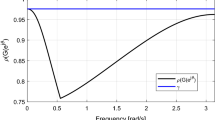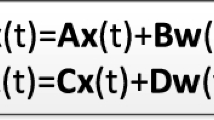Abstract
This paper investigates a Hankel-type model reduction problem for linear repetitive processes. Both differential and discrete cases are considered. For a given stable along the pass process, our attention is focused on the construction of a reduced-order stable along the pass process, which guarantees the corresponding error process to have a specified Hankel-type error performance. The Hankel-type performances are first established for differential and discrete linear repetitive processes, respectively, and the corresponding model reduction problems are solved by using the projection approach. Since these obtained conditions are not expressed in linear matrix inequality (LMI) form, the cone complementary linearization (CCL) method is exploited to cast them into sequential minimization problems subject to LMI constraints, which can be solved efficiently. Three numerical examples are provided to demonstrate the proposed theory.
Similar content being viewed by others
References
Amann N., Owens D.H., Rogers E. (1998). Predictive optimal iterative learning control. International Journal of Control 69(2): 203–206
Du C., Xie L., Soh Y.C. (2001). H ∞ reduced-order approximation of 2-D digital filters. IEEE Transactions on Circuits and Systems (I) 48(6): 688–698
El Ghaoui L., Oustry F., Ait Rami M. (1997). A cone complementarity linearization algorithm for static output-feedback and related problems. IEEE Transactions on Automatic Control 42(8): 1171–1176
Gahinet P., Apkarian P. (1994). A linear matrix inequality approach to H ∞ control. International Journal of Robust & Nonlinear Control 4: 421–448
Galkowski, K., Longman, R. W., & Rogers, E. (Eds.) (2003). International Journal of Applied Mathematics and Computer Science. Special Issue: Multidimensional systems (nD) and iterative learning control, (Vol. 13). University of Zielona Góra Press.
Galkowski K., Paszke W., Rogers E., Xu S., Lam J., Owens D.H. (2003). Stability and control of differential linear repetitive processes using an LMI setting. IEEE Transactions on Circuits and Systems (II) 50(9): 662–666
Galkowski K., Rogers E., Gramacki A., Gramacki J., Owens D.H. (2001). Stability and dynamic boundary condition decoupling analysis for a class of 2-D discrete linear systems. IEE Proceedings on Part G: Circuits Devices Systems 148(3): 126–134
Galkowski K., Rogers E., Xu S., Lam J., Owens D.H. (2002). LMIs – a fundamental tool in analysis and controller design for discrete linear repetitive processes. IEEE Transactions on Circuits and Systems (I) 49(6): 768–778
Gao H., Lam J., Wang C., Wang Q. (2004a) Hankel norm approximation of linear systems with time-varying delay: Continuous and discrete cases. International Journal of Control 77(17): 1503–1520
Gao H., Lam J., Wang C., Xu S. (2004b). H ∞ model reduction for discrete time-delay systems: Delay independent and dependent approaches. International Journal of Control 77: 321–335
Glover K. (1984). All optimal Hankel-norm approximations of linear multivariable systems and their L ∞ -error bounds. International Journal of Control 39(6): 1115–1193
Huang X.-X., Yan W.-Y., Teo K. L. (2001). A new approach to frequency weighted L 2 optimal model reduction. International Journal of Control 74(12): 1239–1246
Liu W.Q., Sreeram V. (2001). Model reduction of singular systems. International Journal of Systems Science 32(10): 1205–1215
Matson J.B., Lam J., Anderson B.D.O., James B. (1993). Multiplicative Hankel norm approximation of linear multivariable systems. International Journal of Control 58(1): 129–167
Moore B. (1981). Principal component analysis in linear systems: Controllability, observability, and model reduction. IEEE Transactions Automatic Control 26(5): 17–31
Paszke, W., Galkowski, K., Rogers, E., Kummert, A., & Owens, D. H. (2005). Mixed H 2-H ∞ and robust control of differential linear repetitive processes. In Proceedings of the 44th IEEE conference on decision and control, Seville, Spain, pp. 7900–7905.
Paszke W., Galkowski K., Rogers E., Owens D.H. (2004). Guaranteed cost control of uncertain differential linear repetitive processes. IEEE Transactions on Circuits and Systems (II) 51(11): 629–634
Paszke W., Galkowski K., Rogers E., Owens D.H. (2006). H ∞ control of differential linear repetitive processes. IEEE Transactions on Circuits and Systems (I) 53(1): 39–44
Pernebo L., Silverman L.M. (1982). Model reduction via balanced state space representations. IEEE Transactions on Automatic Control 27(2): 382–387
Roberts P.D. (2000). Stability analysis of iterative optimal control algorithms modeled as linear repetitive processes. Proceedings of the Institute Electrical Engineers 147: 229–238
Rogers E., Owens D.H. (1992). Stability analysis for linear repetitive processes, volume 175 of Lecture notes in control and information sciences. London, Springer-Verlag
Skelton R.E., Iwasaki T., Grigoriadis K. (1997). A unified algebraic approach to control design. London UK, Taylor & Francis
Xu S., Lam J. (2002). H ∞ model reduction for discrete-time singular systems. Systems & Control Letters 48: 121–133
Xu S., Lam J., Huang S., Yang C. (2001). H ∞ model reduction for linear time-delay systems: Continuous-time case. International Journal of Control 74(11): 1062–1074
Xu S., Lam J., Liu W., Zhang Q. (2003). H ∞ model reduction for singular systems: Continuous-time case. IEE Proceedings Part D: Control Theory Application 150(6):637–641
Yan W.-Y., Lam J. (1999). An approximate approach to H 2 optimal model reduction. IEEE Transactions on Automatic Control 44(7):1341–1358
Zhang L., Huang B., Lam J. (2003). H ∞ model reduction of Markovian jump linear systems. Systems & Control Letters 50(2): 103–118
Zhang L., Lam J. (1999). Optimal weighted L 2 model reduction of delay systems. International Journal of Control 72: 39–48
Zhang L., Lam J. (2002). On H 2 model reduction of bilinear systems. Automatica 38(2): 205–216
Zhou K. (1995). Frequency weighted L ∞ norm and optimal Hankel norm model reduction. IEEE Transactions on Automatic Control 40: 1687–1699
Author information
Authors and Affiliations
Corresponding author
Additional information
This work was partially supported by RGC HKU 7028/04P.
Rights and permissions
About this article
Cite this article
Wu, L., Lam, J. Hankel-type model reduction for linear repetitive processes: differential and discrete cases. Multidim Syst Sign Process 19, 41–78 (2008). https://doi.org/10.1007/s11045-007-0031-2
Received:
Revised:
Accepted:
Published:
Issue Date:
DOI: https://doi.org/10.1007/s11045-007-0031-2




